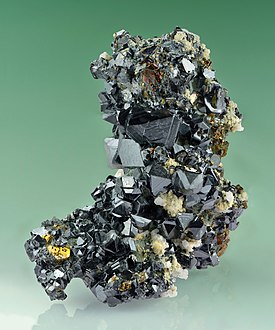| Sphalerite | |
|---|---|
 Black crystals of sphalerite with minor chalcopyrite and calcite | |
| General | |
| Category | Sulfide mineral |
| Formula (repeating unit) | (Zn,Fe)S |
| IMA symbol | Sp[1] |
| Strunz classification | 2.CB.05a |
| Dana classification | 02.08.02.01 |
| Crystal system | Cubic |
| Crystal class | Hextetrahedral (43m) H-M symbol: (4 3m) |
| Space group | F43m (No. 216) |
| Unit cell | a = 5.406 Å; Z = 4 |
| Structure | |
| Jmol (3D) | Interactive image |
| SMILES [SH+2]12[ZnH2-2][SH+2]3[ZnH2-2][SH+2]([ZnH-2]14)[ZnH-2]1[S+2]5([ZnH-2]38)[Zn-2]26[SH+2]2[ZnH-2]([S+2]4)[SH+2]1[ZnH2-2][SH+2]3[ZnH-2]2[S+2][ZnH-2]([SH+2]6[ZnH-2]([SH+2])[SH+2]68)[SH+2]([ZnH2-2]6)[ZnH-2]35 (SMILES input only shows in Preview. SMILES is used to create the Jmol 3D image.) | |
| Identification | |
| Color | Light to dark brown, red-brown, yellow, red, green, light blue, black and colourless. |
| Crystal habit | Euhedral crystals – occurs as well-formed crystals showing good external form. Granular – generally occurs as anhedral to subhedral crystals in matrix. |
| Twinning | Simple contact twins or complex lamellar forms, twin axis [111] |
| Cleavage | perfect dodecahedral on [011] |
| Fracture | Uneven to conchoidal |
| Mohs scale hardness | 3.5–4 |
| Luster | Adamantine, resinous, greasy |
| Streak | brownish white, pale yellow |
| Diaphaneity | Transparent to translucent, opaque when iron-rich |
| Specific gravity | 3.9–4.2 |
| Optical properties | Isotropic |
| Refractive index | nα = 2.369 |
| Other characteristics | non-radioactive, non-magnetic, fluorescent and triboluminescent. |
| References | [2][3][4] |
Sphalerite is a sulfide mineral with the chemical formula (Zn, Fe)S.[5] It is the most important ore of zinc. Sphalerite is found in a variety of deposit types, but it is primarily in sedimentary exhalative, Mississippi-Valley type, and volcanogenic massive sulfide deposits. It is found in association with galena, chalcopyrite, pyrite (and other sulfides), calcite, dolomite, quartz, rhodochrosite, and fluorite.[6]
German geologist Ernst Friedrich Glocker discovered sphalerite in 1847, naming it based on the Greek word sphaleros, meaning "deceiving", due to the difficulty of identifying the mineral.[7]
In addition to zinc, sphalerite is an ore of cadmium, gallium, germanium, and indium. Miners have been known to refer to sphalerite as zinc blende, black-jack, and ruby blende.[8] Marmatite is an opaque black variety with a high iron content.[9]
- ^ Warr, L.N. (2021). "IMA–CNMNC approved mineral symbols". Mineralogical Magazine. 85 (3): 291–320. Bibcode:2021MinM...85..291W. doi:10.1180/mgm.2021.43. S2CID 235729616.
- ^ Sphalerite, WebMineral.com, retrieved 2011-06-20
- ^ Sphalerite, Mindat.org, retrieved 2011-06-20
- ^ Anthony, John W.; Bideaux, Richard A.; Bladh, Kenneth W.; Nichols, Monte C. (2005). "Sphalerite" (PDF). Handbook of Mineralogy. Mineral Data Publishing. Retrieved 14 March 2022.
- ^ Muntyan, Barbara L. (1999). "Colorado Sphalerite". Rocks & Minerals. 74 (4): 220–235. Bibcode:1999RoMin..74..220M. doi:10.1080/00357529909602545. ISSN 0035-7529 – via Scholars Portal Journals.
- ^ Nesse, William D. (2013). Introduction to optical mineralogy (4th ed.). New York: Oxford University Press. p. 121. ISBN 978-0-19-984627-6. OCLC 817795500.
- ^ Glocker, Ernst Friedrich. Generum et specierum mineralium, secundum ordines naturales digestorum synopsis, omnium, quotquot adhuc reperta sunt mineralium nomina complectens. : Adjectis synonymis et veteribus et recentioribus ac novissimarum analysium chemicarum summis. Systematis mineralium naturalis prodromus. OCLC 995480390.
- ^ Richard Rennie and Jonathan Law (2016). A dictionary of chemistry (7th ed.). Oxford: Oxford University Press. ISBN 978-0-19-178954-0. OCLC 936373100.
- ^ Zhou, Jiahui; Jiang, Feng; Li, Sijie; Zhao, Wenqing; Sun, Wei; Ji, Xiaobo; Yang, Yue (2019). "Natural marmatite with low discharge platform and excellent cyclicity as potential anode material for lithium-ion batteries". Electrochimica Acta. 321: 134676. doi:10.1016/j.electacta.2019.134676. S2CID 202080193 – via Elsevier SD Freedom Collection.